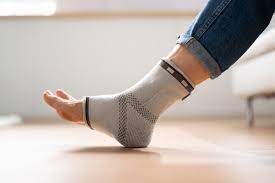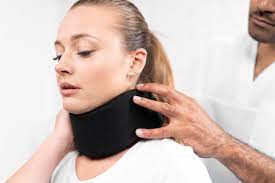Knee Braces
Specifications:
– Material: Neoprene or elastic fabric
– Size: Small, Medium, Large, Extra Large
– Color: Black, Grey, Blue
– Type: Hinged or Non-hinged
– Level of Support: Mild, Moderate, High
Features:
– Compression:
Provides compression to the knee joint to reduce swelling and inflammation.
– Stabilization:
Supports and stabilizes the knee joint to prevent further injury.
– Pain Relief:
Helps to relieve pain and discomfort caused by knee injuries or conditions such as arthritis.
– Range of Motion:
Allows for a specific range of motion while still providing support to the knee joint.
– Breathability:
Made with breathable material to prevent heat buildup and discomfort.
– Durability:
Made with high-quality materials for long-lasting use.
Customization Options:
– Size:
available in different sizes to accommodate different body types.
– Color:
available in different colors to match personal preferences.
– Type:
hinged or non-hinged depending on the level of support needed.
– Level of Support:
mild, moderate, or high depending on the severity of the injury or condition.
Benefits and Features of Knee Braces:
1. Stability:
Knee braces provide stability to the joint, limiting the range of motion and reducing the risk of re-injury.
2. Injury Prevention:
They help to prevent injuries by providing support to the knee joint during physical activity.
3. Pain Relief:
Knee braces help to relieve pain and discomfort caused by knee injuries or conditions such as arthritis.
4. Rehabilitation:
They provide support during rehabilitation after knee surgery or injury, allowing for a quicker and safer recovery.
5. Mobility:
Knee braces can help improve mobility by supporting the joint, allowing the user to move around with less pain and discomfort.
Advantages of Knee Braces:
1. Enhanced Independence:
Knee braces can help people with knee injuries or conditions regain their independence by providing support and stability to the knee joint, allowing them to move around with less pain and discomfort.
2. Improved Quality of Life:
By reducing pain and discomfort, knee braces can improve the quality of life for people with knee injuries or conditions.
3. Increased Confidence:
Knee braces can increase confidence in people with knee injuries or conditions, allowing them to engage in physical activity with less fear of re-injury.
How each Mobility Aid can enhance independence and improve:
1. Knee Braces:
By providing stability and support to the knee joint, knee braces can help people with knee injuries or conditions regain their independence and improve their quality of life.
2. Back Supports:
Back supports can help people with back pain or injuries to improve their posture and reduce pain, allowing them to engage in daily activities with less discomfort.
3. Ankle Braces:
Ankle braces can provide support and stability to the ankle joint, allowing people with ankle injuries or conditions to move around with less pain and discomfort.
Overall, mobility aids such as knee braces, back supports, and ankle braces can provide various benefits and features that can enhance independence and improve the quality of life for people with injuries or conditions.
Back Support
Specifications:
– Material:
The back support brace should be made of high-quality, breathable, and durable materials such as neoprene, elastic, or mesh.
– Design:
The brace should be designed to fit the natural curve of the spine and provide support to the lower back muscles.
– Size:
The brace should come in different sizes to accommodate a range of waist measurements.
– Closure:
The brace should have adjustable closures such as hooks and loops or buckles for a customized fit.
– Support:
The back support brace should provide adequate support to the lower back muscles without restricting movement or causing discomfort.
Features:
– Comfortable:
The brace should be comfortable to wear for extended periods and not cause any skin irritation.
– Breathable:
The brace should be made of breathable materials to prevent sweating and overheating.
– Lightweight:
The brace should be lightweight and not add any unnecessary bulk to the user’s clothing.
– Customizable:
The brace should have adjustable straps or closures to allow for a personalized fit.
– Firm Support:
The brace should provide firm support to the lower back muscles to help alleviate pain and discomfort.
Customization Options:
– Color:
The brace could be available in different colors to suit the user’s preferences.
– Personalization:
The user’s name or initials could be embroidered on the brace for a personalized touch.
– Extra Support:
For users with more severe back pain, the brace could be customized with extra padding or support.
– Heat Therapy:
The brace could be designed to include heat therapy options to help soothe sore muscles.
Back Support Braces can offer a variety of benefits and features that can help individuals manage their back pain and improve their overall quality of life. Some of the key benefits and features of back support braces include:
key benefits and features of back support braces include
1. Improved posture:
Back support braces can help to promote proper posture by encouraging the spine to maintain a neutral position. This can be especially beneficial for individuals who spend long hours sitting at a desk or standing for extended periods, as poor posture can lead to chronic back pain and discomfort.
2. Reduced pain and discomfort:
Back support braces can provide additional support to the muscles and ligaments in the lower back, helping to reduce strain and pressure during everyday activities such as lifting, bending, and twisting. This can help to alleviate pain and discomfort associated with back injuries or chronic conditions such as arthritis.
3. Increased support during physical activity:
Back support braces can help stabilize the spine during physical activity, reducing the risk of injury and promoting faster healing from existing injuries.
4. Customizable fit:
Many back support braces come with adjustable straps or sizing guides, allowing individuals to customize the fit to their specific needs. This can help to ensure maximum comfort and support during use.
Advantage:
The main advantage of back support braces is that they can help individuals manage their back pain and improve their overall mobility and independence. By reducing pain and discomfort in the lower back, individuals may find it easier to perform daily tasks such as walking, climbing stairs, and carrying groceries. This can help to enhance their independence and improve their overall quality of life. Overall, back support braces offer a range of benefits and features that can help individuals manage their back pain and improve their overall mobility and independence. Whether you are recovering from an injury or simply looking to improve your posture and reduce back pain, a back support brace may be a valuable addition to your daily routine.
Ankle Braces
Specification:
– Made of breathable and lightweight materials to provide comfort and support
– Designed to fit both left and right ankle
– Available in different sizes to accommodate various foot sizes
– Provides adjustable compression to ensure a secure fit
Features:
– Provides stability and support to the ankle joint
– Helps reduce swelling and inflammation
– Designed to prevent further injury or re-injury
– Can be worn during physical activity or as daily support
Customization options:
– Available in different colors and designs
– Can be customized to fit specific ankle shapes or sizes
– Some ankle braces come with removable inserts or pads for added support and comfort
– Can be designed to accommodate different levels of activity or injury severity.
Benefits and Features of Ankle Braces:
– Provides support and stability to the ankle joint, reducing the risk of further injury or re-injury
– Helps to reduce swelling and inflammation in the ankle
– Designed to be comfortable and lightweight, allowing for extended wear during physical activity or daily use
– Can be adjusted for a personalized fit and level of compression
– Some ankle braces come with additional features such as removable inserts or pads for added support and comfort
Advantages of Ankle Braces:
– Ankle braces can be used to treat and prevent various ankle injuries, such as sprains, strains, and fractures
– They can help individuals with ankle instability or weakness regain confidence and mobility
– Ankle braces can be used during physical activity to provide additional support and protection to the ankle joint, reducing the risk of injury and allowing for a safer and more enjoyable experience
How each Mobility Aid can Enhance Independence and Improve:
– Mobility aids such as wheelchairs, scooters, walkers, and canes can help individuals with mobility challenges regain independence and improve their quality of life
– These aids can provide support and assistance with daily activities such as walking, standing, and transferring
– Mobility aids can help to reduce the risk of falls and injuries, allowing individuals to maintain their mobility and independence for longer periods
– They can also help individuals to participate in social activities and hobbies, improving their mental and emotional well-being.
Braces

Knee Braces:
Purpose:Provide support and stability to the knee joint.
Types:Prophylactic braces: Prevent injuries, often used in sports.
Functional braces: Support and stabilize injured knees during activities.
Unloader/offloader braces: Reduce pressure on a specific part of the knee, often used for arthritis.

Ankle Braces:
Purpose:Support and protect the ankle joint.
Types:Lace-up braces: Provide compression and stability.
Stirrup braces: Support both sides of the ankle.
Hinged braces: Allow controlled movement while providing support.

Neck Braces:
Purpose:Immobilize and support the neck after injury or surgery.
Types:Soft collars: Provide mild support for minor neck injuries.
Hard collars: Restrict neck movement for more severe injuries.

Back Braces:
Purpose:Stabilize and support the spine, often used for back pain.
Types:Corset braces: Wrap around the torso to support the lower back.
Rigid braces: Provide maximum support and restrict movement.
Soft braces: Offer moderate support and flexibility.
